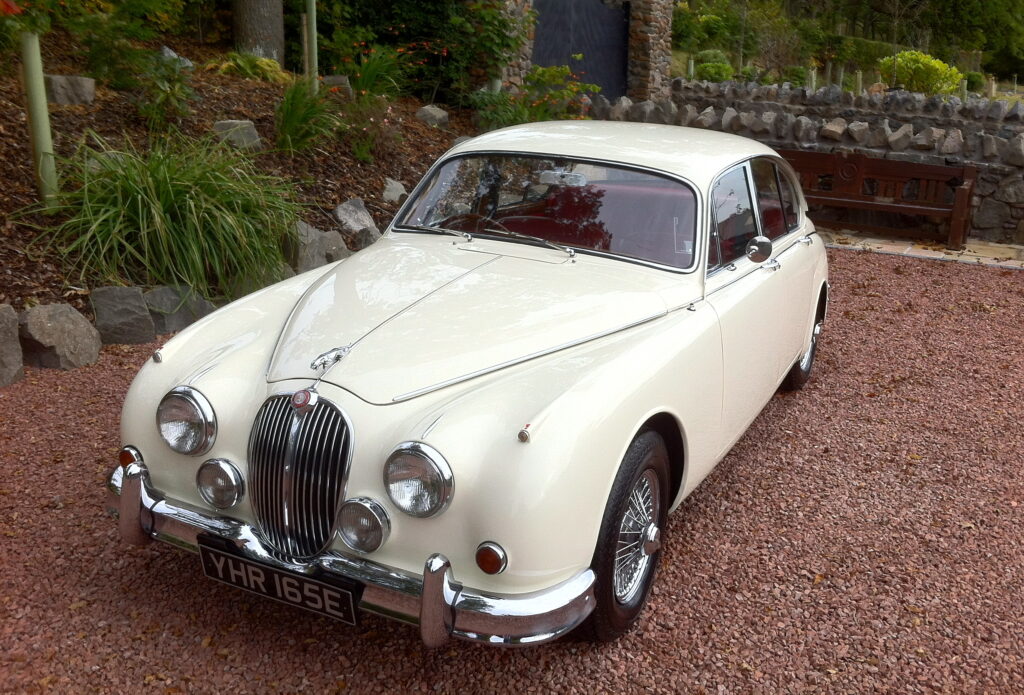
1966 Jaguar Mark II: A Detailed Historical Perspective
The Jaguar Mark II is often cited as one of the quintessential British saloons of its time. Introduced initially in 1959, by 1966 this car had firmly established itself as a symbol of elegance, performance, and engineering prowess.
Design and Styling
The Mark II was a product of Jaguar’s legendary design team led by the company’s founder, Sir William Lyons. The car was a departure from its predecessor, the Jaguar Mark I, with an emphasis on a more refined and larger glass area. The distinctive chrome-surrounded windows became one of the car’s signature looks.
One of the key design changes from the Mark I was the integration of a wider rear track. This modification was not just aesthetic; it greatly improved the car’s handling, making it a driver’s delight. The car’s compact yet graceful lines were accentuated by the iconic slender chrome bumpers, a distinctive grille, and a set of four round headlights that lent the Mark II an aggressive yet refined stance.
Engine and Performance
Under the bonnet, the Mark II offered a range of engine options. However, the engine that stood out the most and which made the Mark II especially renowned was the XK engine. By 1966, buyers had three choices:
- 2.4-liter, producing about 120 hp.
- 3.4-liter, giving a robust 210 hp.
- 3.8-liter, the same engine as found in the Jaguar E-type, with an impressive 220 hp.
The 3.8-liter engine variant, coupled with a 4-speed manual transmission (with or without overdrive) or a 3-speed automatic, was particularly notable for its performance. It could accelerate from 0-60 mph in around 8.5 seconds and achieve a top speed of 125 mph – remarkable figures for a saloon of its time.
Racing History
The Jaguar Mark II didn’t just limit itself to the roads; it made a significant impact on the racetracks as well. Given its robust performance capabilities, especially with the 3.8-liter engine, the Mark II became a favorite among racers and was a frequent sight in touring car races in the early 1960s.
One of the most notable racers to use the Mark II was the legendary Roy Salvadori. In saloon car races, the Mark II 3.8 often locked horns with other potent machines of its time, such as the Lotus Cortina. The Mark II’s racing endeavors bolstered its image as a saloon that could offer both luxury and speed.
Interiors and Comfort
Inside, the Mark II boasted an opulence and attention to detail that were unparalleled for its price range. The deep-set walnut veneer dashboard housed a comprehensive set of Smiths gauges, exuding a sense of luxury. Plush leather seats, door trims embroidered with quality materials, and a robust feel of all the switchgear made the interior a very special place to be.
Jaguar, through its Mark II, was demonstrating that luxury and performance could coexist harmoniously within the confines of a four-door saloon.
1966: The Swan Song
By 1966, the Mark II was approaching the end of its production life. It had seen various refinements and improvements over its lifespan. Production would cease a year later in 1967, making way for its successor, the 240 and 340 models. However, the legacy of the Mark II remains intact even today. It was not merely a car; for many, it was a symbol of a golden era of British automotive design and engineering.
In popular culture, the Mark II has had its share of fame, often being associated with detective series and films. This only accentuated its image as a car that was as cerebral as it was athletic.
Conclusion
In its entirety, the Jaguar Mark II was not just another car in the annals of automotive history. It was a representation of an era and a statement of intent from Jaguar. A car that blended design, luxury, and performance so seamlessly, it remains an icon of its time. Sir William Lyons and his team at Jaguar crafted a masterpiece that captured the imaginations and hearts of many, and the Mark II continues to be revered as one of the pinnacles of British automotive design and engineering.
Are you looking to sell your classic 1966 Jaguar Mark II? Give us a call at (310) 399-3990 or email us at info@westcoastclassics.com and we’ll give you a free quick quote. At Sell a Classic Car, we buy your vintage vehicles with the least possible inconvenience to you.
